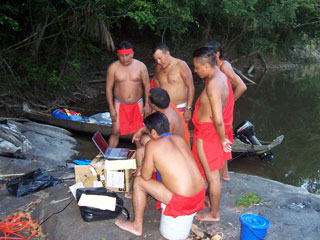Many of these populations existed along whitewater rivers where they had good means of transportation, excellent fishing, and fertile floodplain soils for agriculture. However, when Europeans arrived, these were the first settlements to be affected, since Europeans used the major rivers as highways to the interior. In the first century of European presence, the Amerindian population was reduced by 90 percent. Most of the remaining peoples lived in the interior of the forest: either pushed there by the Europeans or traditionally living there in smaller groups.
From Pizarro's conquest of the Inca empire until the end of the Brazilian rubber boom around the beginning of World War I, the Spanish and Portuguese, in the name of Catholicism with the blessing of popes, continued the long tradition of abuse against these people—one that would be continued by colonists, rubber tappers, and land developers.
Amazonians Today
|
Today almost no forest Amerindians live in their fully traditional ways. Perhaps only a few small groups in the Amazon basin can still claim to do so. One of these, the Tageri (part of the Waorani group), is highly threatened by oil development in Ecuador. Its plight has become an international battle among environmentalists, human rights activists, the government, and the oil industry.
Indian social mobilization of American indigenous peoples has attained the highest organization of any rainforest region. Forming ethnic organizations is one way to protect themselves, their culture, and their natural forest resources. Amerindians have faced a long, bitter battle against development of their land by outsiders, and today these organizations monitor these incursions on their lands. The Indian Missionary Council, CIMI, reported that land invasions of Brazilian Indian reservations by loggers and miners has risen since the mid-1990s. Loggers are increasingly trespassing on indigenous lands in search of mahogany, which can no longer be legally logged in Brazil. In the late 1990s and early 2000s, clashes between indigenous peoples and loggers, miners, and oil developers received some exposure in the Western press, notably the on-going saga between the native Yanomani of Brazil and Venezuela and thousands of small-scale miners, known as "garimpeiros" in Brazil, who often illegally mine on the natives' demarcated lands.
 Using Google Earth and other technology to protect indigenous rights in the Amazon Deep in the most remote jungles of South America, Amazon Indians (Amerindians) are using Google Earth, Global Positioning System (GPS) mapping, and other technologies to protect their fast-dwindling home. Tribes in Suriname, Brazil, and Colombia are combining their traditional knowledge of the rainforest with Western technology to conserve forests and maintain ties to their history and cultural traditions, which include profound knowledge of the forest ecosystem and medicinal plants. Helping them is the Amazon Conservation Team (ACT), a nonprofit organization working with indigenous people to conserve biodiversity, health, and culture in South American rain forests. |
Brazil has set aside large tracts of forests—roughly 12.5 percent of Brazil's total land area and 26.4 percent of the Amazon basin—for the indigenous population, which is made up of about 450,000 Indians or 0.25 percent of the total population. These indigenous reserves—set forth under Brazil's 1988 constitution—have helped the country's Indian population to rebound after centuries of decline. According to The Economist [Feb 2nd 2006], 60 percent of Brazil's Indian population lives in the Amazon.
These protected areas are not popular among poor farmers, landowners, and developers, who have tried to fight the establishment of new parks and indigenous reserves and are known to illegally exploit forest resources—especially mahogany and other valuable timber—within the boundaries of protected areas. Nevertheless, a 2006 studyconducted by researchers at the Woods Hole Research Center and the Instituto de Pesquisa Ambiental da Amazonia, found that parks and indigenous reserves in the Amazon help slow deforestation. Using quantitative analysis of satellite data, the research concluded that deforestation and the incidence of fires was significantly lower inside the perimeter of reserves and demarcated indigenous lands.
